Bridal Outfit Shopping 101: A Complete 10-Item Checklist for Brides
Hey beautiful bride-to-be, we know how thrilling and overwhelming the bridal outfit shopping journey can be. From dreaming about that perfect lehenga to juggling timelines, budgets, and fittings, it’s a lot! But don’t worry, Team Plannersy is here to make this adventure joyful and organized.
With our thoughtfully crafted Bridal Outfit Shopping Checklist, you’ll have everything you need to shop smartly and stylishly, without missing a beat. Because your bridal look deserves to be flawless, fun, and truly you.
Let’s dive into the essential steps, tips, and must-haves that every bride should tick off, so you can focus on feeling radiant and ready for your big day!
1. Set Your Budget Early
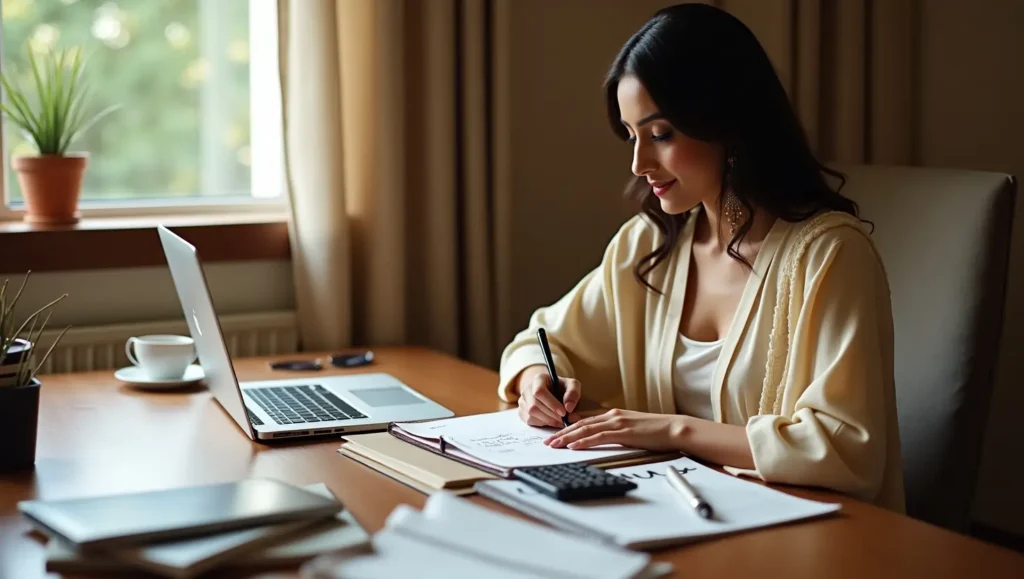
Setting your budget is the very first and most crucial step in your bridal outfit shopping journey. Weddings come with multiple expenses, and knowing how much you can comfortably spend on your bridal outfit helps you make smart choices without overspending or feeling stressed later on.
Why Budgeting Matters:
- Narrows Down Options: The bridal outfit market is vast, from high-end designer lehengas to budget-friendly boutiques. A clear budget helps you focus on options within your price range, saving time and energy.
- Avoids Overspending: Wedding excitement can sometimes push you to splurge impulsively. A budget keeps your spending in check.
- Facilitates Planning: Knowing your budget allows you to allocate funds to other important wedding elements like accessories, makeup, and flowers.
How to Set Your Budget:
- Review your overall wedding budget and decide what portion you can comfortably assign to your bridal attire. Typically, bridal wear can take 10-20% of your total wedding budget, depending on your priorities.
- Keep a buffer of 10-15% for unexpected costs such as additional embroidery, customizations, or last-minute accessory purchases.
- Discuss your budget with your family or planner upfront to avoid surprises.
Plannersy Pro Tip:
Be realistic but flexible. Sometimes investing a bit more in your bridal outfit, which you will cherish forever, is worth it. But equally important is to resist pressure and stick to your financial comfort zone.
2. Finalize Your Wedding Theme & Colors
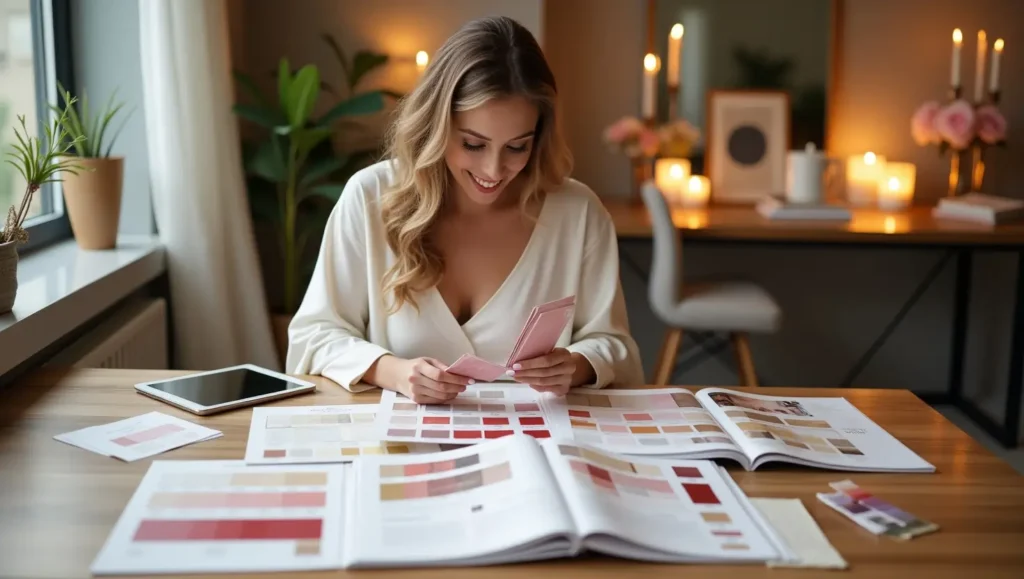
Before diving into outfit shopping, it’s essential to have a clear idea of your wedding theme and color palette. Your bridal outfit should harmonize beautifully with the overall vibe of your wedding day, think of it as the star that complements the entire show.
Why This Step is a Game-Changer:
- Creates Cohesion: When your outfit matches or complements your wedding décor, invitations, and even bridesmaids’ looks, it creates a visually stunning, cohesive experience.
- Guides Your Outfit Choices: Knowing your theme helps you choose fabrics, embroidery, and styles that fit the mood, be it royal, rustic, vintage, or modern.
- Avoids Last-Minute Conflicts: Deciding colors late can lead to mismatched tones and confusion, wasting valuable time and energy.
How to Choose Your Theme & Colors:
- Reflect on your personal style and what resonates with you: soft pastels, rich jewel tones, or classic reds?
- Consider the venue and season: A beach wedding calls for breezy light colors, while a winter palace wedding might call for richer, warmer tones.
- Coordinate with your fiancé and family to ensure everyone’s vision aligns.
Plannersy Pro Tip:
Many brides find inspiration by creating mood boards with images of décor, flowers, and outfits. Apps like Pinterest are great for this! This way, when you visit designers or stores, you can clearly communicate your vision, making the process smoother and more fun.
3. Research & Shortlist Designers/Stores
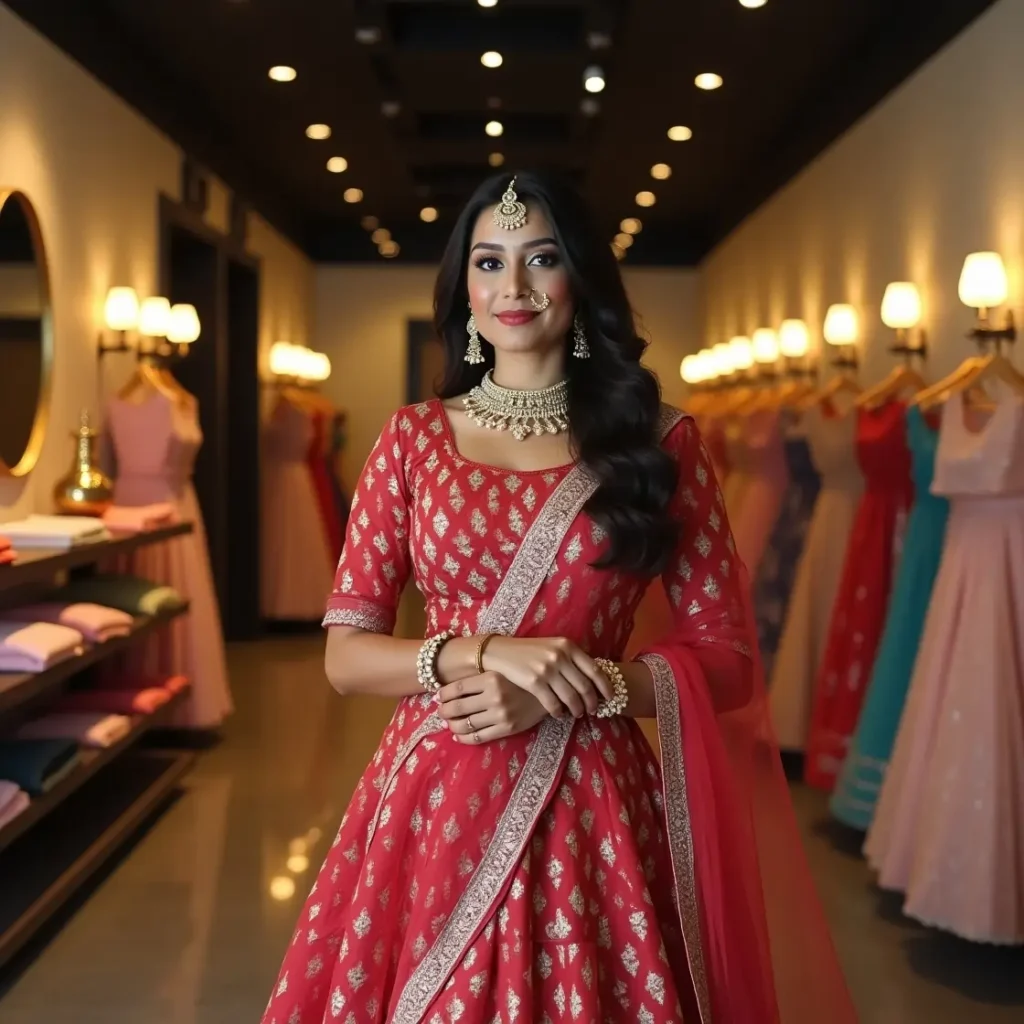
Before stepping into stores or booking appointments, it’s essential to spend time researching designers and boutiques that align with your style, preferences, and budget.
What to Do:
- Identify Your Style: Decide whether you’re leaning towards traditional, modern, minimalistic, or royal bridal looks. This will help you filter designers quickly.
- Explore Online: Use Instagram, Pinterest, and wedding platforms like WedMeGood or WeddingWire to check real bride looks, designer portfolios, and store reviews.
- Mix Your Options: Shortlist a mix of high-end designers, mid-range labels, and budget-friendly boutiques. Keep your list flexible; sometimes a lesser-known boutique surprises you with the perfect outfit.
- Check Reviews: Go beyond pretty photos. Look for feedback on fittings, fabric quality, delivery timelines, and service experience.
- Start a Tracker: Maintain a simple list with designer/store name, location, price range, and notes. It helps keep your options organized when you start visiting places.
Plannersy Pro Tip
Don’t overlook regional designers or multi-designer stores, they often carry fresh designs at more affordable rates with great customization support.
4. Schedule Shopping Appointments Early
Once you’ve shortlisted designers and stores, the next step is to book your appointments well in advance, especially if your wedding falls in peak season.
Why It Matters:
- Top designers and boutique slots fill fast, and walk-ins might mean longer wait times or limited availability.
- Early appointments give you time to browse without pressure and leave room for multiple trials, customizations, or design tweaks.
When to Start:
- Start scheduling appointments 6–8 months before your wedding, especially if you’re planning on custom outfits or bridal couture.
Pro Tips:
- Opt for Weekdays or Mornings: Stores are less crowded, and staff are more attentive.
- Keep One Day for One Area: If you’re exploring multiple stores in a market like Santacruz or Shahpur Jat, plan them all for one day to save time and energy.
- Take a Notebook or Notes App: Jot down prices, timelines, and what you liked/disliked about each place, it’ll help during final decisions.
Plannersy Pro Tip
Always confirm appointments a day prior and ask if you can bring a trusted friend or family member for a second opinion.
5. Keep Your Wedding Dates & Timelines Handy
Bridal outfit planning is all about timing, and having your wedding dates ready ensures everything runs smoothly.
Why It’s Important:
- Designers and boutiques need your event dates to schedule trials, fittings, and final deliveries.
- It helps you prioritize which outfits are needed first (e.g., engagement, mehendi, wedding, reception).
- Certain embroideries or customizations may take weeks to months, especially for handwork or imported fabrics.
Ideal Timelines:
- Main Bridal Outfit: Order at least 4–6 months in advance.
- Other Ceremony Outfits: Finalize 3–4 months ahead.
- Fittings: Start 2 months before, with at least two fitting sessions spaced out.
Plannersy Pro Tip
Bring a printed or digital timeline with all wedding-related dates when you shop. It helps the designer align production schedules and prevent last-minute panic.
6. Prepare a Mood Board
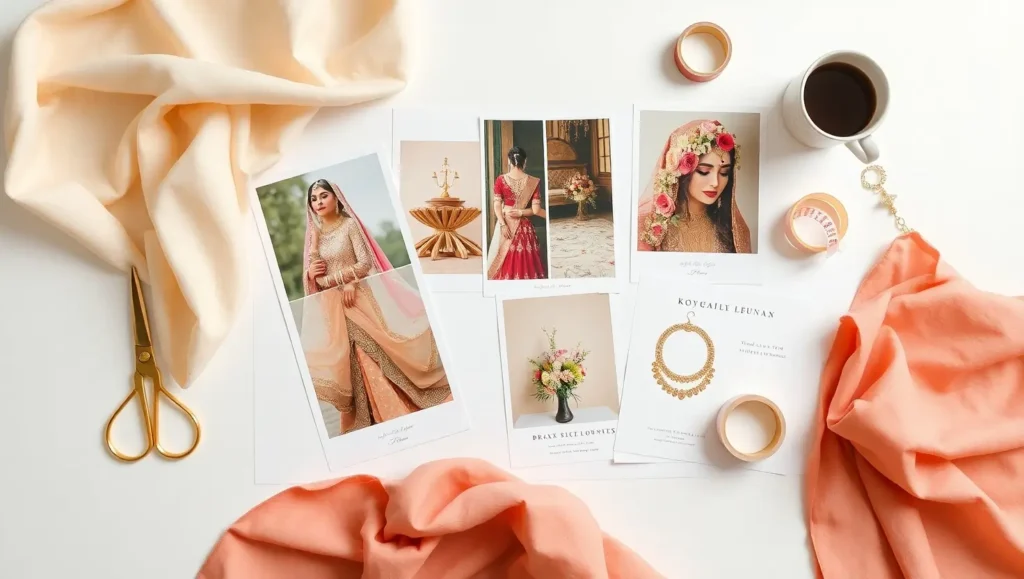
Before stepping into showrooms or designer studios, create a mood board to visualize your dream bridal look. It’s a simple yet powerful tool to guide your shopping and communicate your vision clearly.
Why It Matters:
- Helps you stay consistent with your style, color palette, and vibe.
- Prevents overwhelm when faced with endless choices.
- Makes it easier to share your preferences with designers, stylists, or family members.
What to Include:
- Outfit silhouettes you love (e.g., A-line lehenga, saree with cape).
- Favorite fabrics, embroidery styles, and color tones.
- Inspirational looks from celebrity brides, Pinterest, or Instagram.
- Accessories, hairstyles, and makeup pegs that match your look.
How to Create One:
- Use Pinterest, Canva, or a simple photo collage app.
- If you prefer offline, use a notebook or scrapbook with magazine cut-outs.
- Group your ideas by event, Mehendi, Sangeet, Wedding, Reception, for clarity.
Plannersy Pro Tip
Bring your mood board to appointments, it’ll help designers understand your taste faster and offer options that align with your dream aesthetic.
7. Choose Comfortable Fabrics
While your bridal outfit should be stunning, it must also let you breathe, move, and enjoy your big day comfortably. Beauty shouldn’t come at the cost of ease, especially when you’ll be wearing the outfit for hours.
Why Comfort Matters:
- Weddings often involve long rituals, dancing, and warm lights ,you’ll want something that lets you move freely.
- Uncomfortable fabric can lead to irritation, overheating, or constant adjusting, distracting you from your special moments.
Fabrics That Balance Style & Comfort:
- Georgette: Lightweight and flowy, great for twirls and easy movement.
- Chiffon: Elegant drape, especially ideal for summer weddings.
- Soft silk or crepe: Offers a luxe look with breathable comfort.
- Organza: Crisp yet light, adds volume without weight.
- Net or tulle with soft lining: For a fairy-tale look without bulk.
Consider Based on Occasion:
- Go for heavier fabrics like velvet or brocade only for cooler climates or shorter wear durations.
- Choose lightweight fabrics for daytime, beach, or outdoor functions.
Plannersy Pro Tip
Always try on sample outfits at the store, not just for the look, but to feel how the fabric sits on your body when walking, sitting, and moving.
8. Plan Your Accessories in Advance
Accessories are the finishing touch that elevate your bridal outfit from beautiful to breathtaking. Planning them early ensures your overall look is cohesive, balanced, and reflects your personality.
Why It’s Important:
- The right jewelry and accessories enhance your outfit, highlight your features, and align with your wedding theme.
- Early planning avoids last-minute mismatches and rushed purchases that may not complement your bridal look.
What to Plan For:
- Jewelry: Necklace sets, maang tikka, earrings, bangles, rings, nath, kamarbandh, anklets.
- Footwear: Comfortable yet stylish, think about the surface you’ll walk on and the length of your outfit.
- Clutch/Potli: Useful for small essentials and adds elegance.
- Hair Accessories: Floral additions, pins, matha pattis, or veils.
- Dupatta Draping Pins: Keep extras handy for styling and function.
Smart Tip:
Take photos of your outfit while shopping. It helps you match shades of golds, silvers, or colored stones with your accessories perfectly.
Plannersy Pro Tip
Make a small list and shop for accessories in parallel with your outfit trials. That way, nothing feels like an afterthought, and you can make room in your budget early on.
9. Consider Versatility & Comfort
Your bridal outfit might look stunning in photos, but you’ll be wearing it for hours. From rituals to dancing and greeting guests, comfort and functionality should be at the heart of your outfit planning.
Why Versatility Matters:
- Multiple Events: You may want a statement piece for the main ceremony and something lighter for pre-wedding functions like the mehendi or sangeet.
- Post-Wedding Use: A versatile lehenga or saree can be restyled for future occasions or even repurposed into lighter separates.
Things to Keep in Mind:
- Choose lighter fabrics and manageable silhouettes for day events or outdoor settings.
- Consider modular outfits (like detachable dupattas, capes, or sleeves) for easier movement.
- Look for designs you can re-wear by mixing and matching with other pieces later.
Comfort Is Key:
- Try sitting, walking, and lifting your arms in your outfit during fittings.
- Avoid styles that pinch, restrict movement, or weigh you down.
- Add soft lining or padding where needed to avoid chafing from embroidery or zippers.
Plannersy Pro Tip
If your dream lehenga feels too heavy, consider getting a duplicate lighter version made for the reception or post-wedding shoot. This way, you won’t have to compromise on the look or your comfort.
10. Book Your Tailor/Fitting Sessions Early
Even the most stunning bridal outfit needs the perfect fit to truly shine. Once you’ve finalized your lehenga, saree, or gown, getting timely and professional alterations is non-negotiable.
Why Early Tailoring Matters:
- Perfect Fit: Every bride’s body is unique, and off-the-rack or custom outfits still require adjustments.
- Avoid Last-Minute Panic: Tailors get busy during wedding seasons, booking early ensures enough time for multiple trials.
- Weight Fluctuations: In case of minor body changes before the wedding, early fittings give you flexibility.
What to Do:
- Book Your Tailor Right After Purchase: Don’t wait until the last moment to start fittings.
- Schedule 2–3 Fittings: The first for basic adjustments, the second for fine-tuning, and one final fitting for last checks.
- Carry Accessories to Fittings: Bring your wedding shoes, blouse, and accessories so the tailor can fit everything precisely.
Plannersy Pro Tip
Always do a complete trial walk, sit, and move-around session in your bridal outfit. This will help catch small discomforts like tight zippers, loose waistbands, or dragging hemlines.
Shopping for your bridal outfit is a thrilling journey that requires careful planning and thoughtful decisions. From researching designers to scheduling fittings and ensuring safe storage, each step plays a vital role in creating your perfect wedding look. By following this checklist, you can stay organized, reduce stress, and confidently choose a bridal outfit that reflects your style, comfort, and wedding theme.
Remember, your bridal attire is not just a dress; it’s the centerpiece of your big day, so give it the attention it deserves!
-Team Plannersy

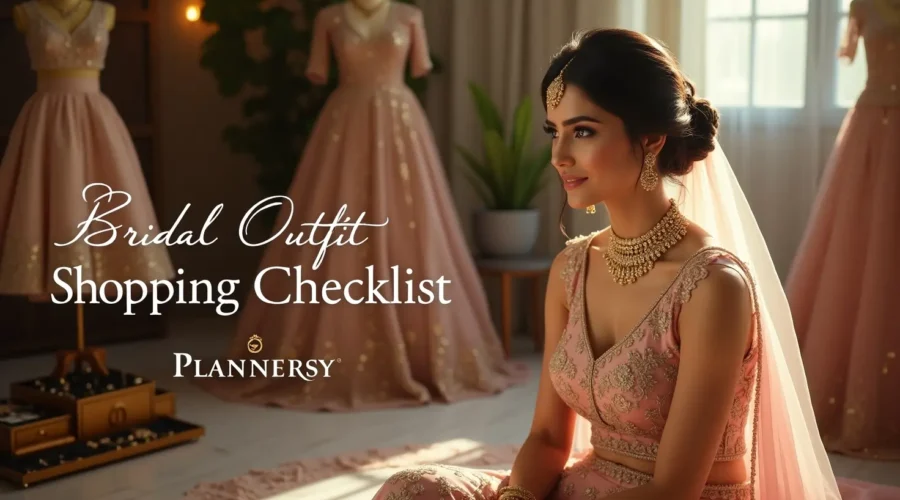
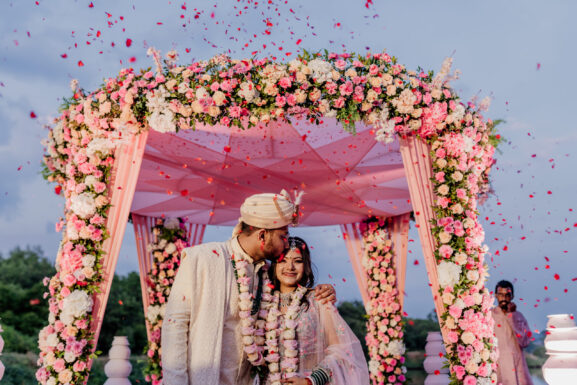
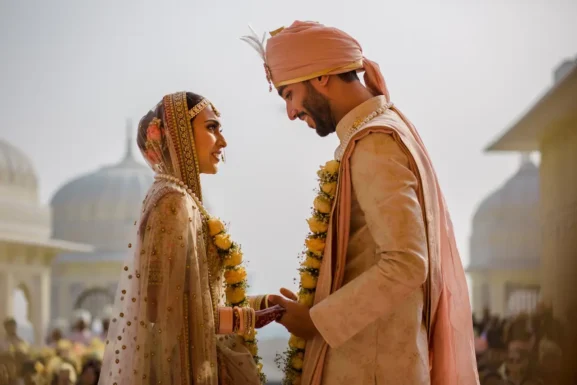
Pingback: Wedding Shopping in Jaipur: Your Dreamy Guide to Lehengas, Jewellery & Hidden Gems - Plannersy